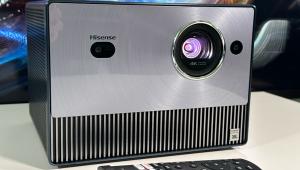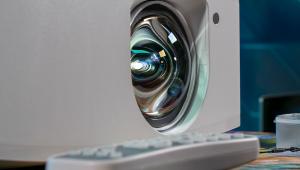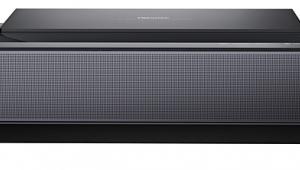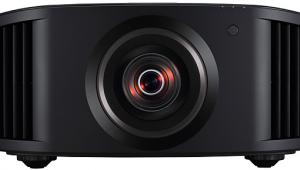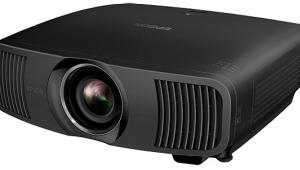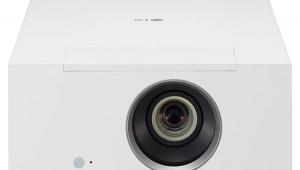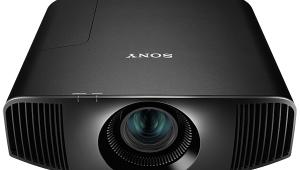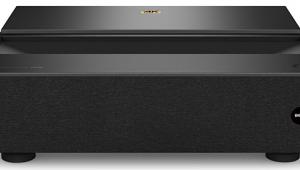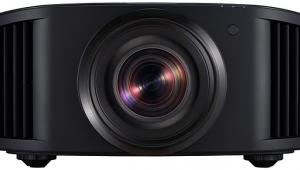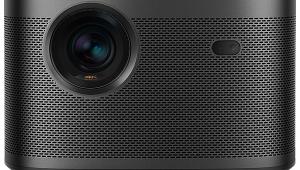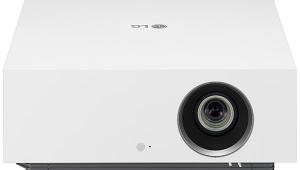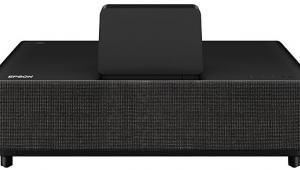Sony VPL-VW325ES 4K LCOS Projector Review Page 2
HD/Standard Dynamic Range Performance
As I stated above, the VW325ES with its Cinema Film 2 mode active delivered more than acceptable image quality. After fine-tuning brightness/contrast, calibrating grayscale, and tweaking Reality Creation settings to eke out that very last ounce of detail, its picture looked nothing short of fantastic with most discs and video streams I watched. An AFC championship football game between the Bills and Chiefs came across as clean and finely detailed, with bright primary colors in the uniforms popping off the screen and the whites looking neutral and well-balanced. The only complaint I had was that I needed to turn the lights off to achieve this level of performance—the VW325ES is happiest in a dark room, which is not always the optimal environment for sports-watching.
 Keeping things dark, I watched a Criterion Collection Blu-ray release of David Lynch's Elephant Man. In an early scene that takes place in a dank basement where the sideshow performer (real name, Joseph Merrick) is housed by his cruel handler, the black-and-white filmed image looked impressively nuanced, with finely rendered gray tones and excellent edge-to-edge image uniformity. But with no dynamic iris to assist in dimming blacks, letterbox bars in the 2.35:1 image appeared dark gray, and the deepest shadows also came across as the same dark gray tone. Even so, shadow detail was very good overall, and shadow depth was superior to what I'm used to getting with DLP-based 4K projectors, which typically have a very limited contrast ratio.
Keeping things dark, I watched a Criterion Collection Blu-ray release of David Lynch's Elephant Man. In an early scene that takes place in a dank basement where the sideshow performer (real name, Joseph Merrick) is housed by his cruel handler, the black-and-white filmed image looked impressively nuanced, with finely rendered gray tones and excellent edge-to-edge image uniformity. But with no dynamic iris to assist in dimming blacks, letterbox bars in the 2.35:1 image appeared dark gray, and the deepest shadows also came across as the same dark gray tone. Even so, shadow detail was very good overall, and shadow depth was superior to what I'm used to getting with DLP-based 4K projectors, which typically have a very limited contrast ratio.
Moving on to another Blu-ray black-level torture test, I watched the early cave and "space waltz" scenes from the remastered 2018 release of 2001: A Space Odyssey. The black depth in both came up short of what I've seen from projectors that offer a dynamic iris, but it was still fairly good. Color and skin tones in subsequent scenes looked completely natural, while the level of detail I was getting even with a regular HD Blu-ray source was strikingly 4K-like.
HDR/High Dynamic Range Performance
Switching over to 4K/HDR viewing certainly kicked things up a notch with the VW325ES. Watching the Ultra HD disc from the same 2001: A Space Odyssey package, the brighter, more powerful highlights added greater depth to the image, something that was especially visible in starfields during the space waltz shots. When displaying HDR, the Contrast Enhancer function becomes a "Dynamic HDR Enhancer" with High, Middle and Low options. This is a limited menu compared to similar functions on other projectors that offer a wider range of steps—typically 10 or more—to adjust HDR tone mapping, but I found that the Middle option worked best for most movies. (The High setting in comparison tended to blow out highlight detail in some cases.)
Streaming the animated film Encanto from the Disney+ service in 4K/HDR, I was literally mesmerized by what I was seeing with the VW325ES. Colors were bright and rich, and the image had an dynamic overall quality that exceeded pretty much everything else I had watched up to that point. Bright highlights looked intense, though not overly aggressive, and black backgrounds in the night scenes came across as thoroughly solid.
Streaming a different 4K/HDR movie, Kimi, from HBO Max, also proved illuminating. This Steven Soderbergh-directed release, one that does an excellent job of weaving smart home technology into the plot—Kimi is an Alexa-like AI voice control tech that the protagonist, Angela Childs, (Zoë Kravitz) works with professionally to adjust and perfect—looked razor sharp with the VW325ES. Most scenes displayed impressive shadow detail in the large loft space where Angela lives/works. But darker scenes in the same space toward the end when she is struggling with her would-be executioners (yeah, you'll have to watch for yourselves) had a somewhat murkier appearance, even after I boosted the Dynamic HDR Enhancer to the High setting. Are there too many variables involved with video streaming to make a proper call on the Sony's HDR performance here? Perhaps, but a wider range of tone mapping adjustments nevertheless might have allowed me to dial in a better-looking image.

The content I watched that probably gave me the best sense of the Sony projector's capabilities was Dune on Ultra HD Blu-ray. The 4K image looked impeccably clean with the VW325ES, with details such as the texture of uniforms and fabric capes coming through with a high level of crispness. Special effects shots had a stunningly realistic look, and while this doubtless had much to do with the quality of the film's production, it also seemed like the Sony's natural and seamless presentation was also contributing to the experience. (Dune actually looked better to me here than I recall when seeing it in a theater, but given the shortcomings of most movie theaters, that's not too far a stretch.) And while colors in Dune are mostly muted—the bright blue eyes of the Fremen being one exception—the subtle HDR implementation in some scenes, especially in the floating glowglobes that follow characters around, was effectively rendered.
Conclusion
Even with its $5,499 price, Sony's VPL-VW325ES is still the lowest-cost projector you can buy with full 4K imaging chips. That lets you rest assured that this entry-level model delivers the same level of stunning picture detail as pricier projectors further up the Sony line. The new X1 For Projector picture processor found in the VW325ES delivers the same excellent video processing and upscaling as you get in the company's its flat-panel TVs, while the impressive native contrast of the SXRD chips means that images have strong contrast and solid-looking blacks.
Are there shortcomings in the VW325ES that you might not find in the company's higher-end models? The lack of a dynamic iris means that its contrast ratio, while good, isn't as impressive as what you can expect to see on projectors that provide that feature. Also, with just 1,500 lumens specified light output, it's not as bright as its competition. That means that a dark viewing environment is necessary to get the best performance out of the VW325ES, and it's not an ideal choice for applications like sports where you're likely to be viewing in daylit conditions. And while limited light output doesn't necessarily matter for gaming, Sony's entry level projector also doesn't provide HDMI 2.1 inputs with support for 4K/120Hz, Variable Refresh Rate (VRR), or Auto Low Latency Mode (ALLM)—features that are of interest to gamers. But even with those few caveats, I'd easily recommend the VW325ES as a great all-around choice for movie fans who want to see discs and streams looking their best on the big screen without spending a fortune.
- Log in or register to post comments


